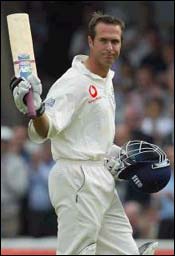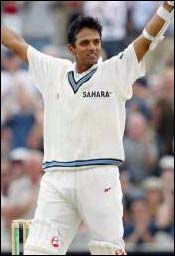India emerge with honours
Daniel Laidlaw
The turnaround fashioned by India in the drawn fourth Test proved something of a microcosm of the series in which, ultimately, India emerged with the
honours.
At 336/2, a quickly-compiled England total in excess of 600, with resulting
pressure on India's batsmen to save the match and series, appeared close to
inevitable. But as the destiny of the series was turned around commencing
with the rearguard second innings at Trent Bridge, so too were the fortunes
of the fourth Test after the opening day.
It is unfortunate that the toss played such a crucial part in shaping the
decisive match. Given the placid nature of the pitch, the side batting first
was always favoured to virtually close the other out of the game, dulling
the edge of the contest. It could just as easily have been the tourists in
an identical position by the end of day one, and with the potential of
Harbhajan and Kumble to make the most demands on the batsmen, that would
probably have been the best chance of a result either way. Barring an
egregious calamity or something truly inspired, though, the balance of the
teams wasn't conducive to achieving a result within the scheduled time.
 That shouldn't have meant being resigned to fate upon the fall of the coin,
but there was an air of inevitability in the manner in which the immensely
confident Vaughan and company eased away. Frankly, it was surprising as many
as two wickets fell on the first day, such was the untroubled skill and
sang-froid with which Vaughan batted.
That shouldn't have meant being resigned to fate upon the fall of the coin,
but there was an air of inevitability in the manner in which the immensely
confident Vaughan and company eased away. Frankly, it was surprising as many
as two wickets fell on the first day, such was the untroubled skill and
sang-froid with which Vaughan batted.
India's hope lay in emulating Sri Lanka's Oval win in 1998, when an England
total of 445 was quickly surmounted and Muralitharan wreaked havoc. To
create even a remote chance of that, England first had to be limited, and
the catalyst was the utilitarian Sanjay Bangar.
Bangar appears an unassuming cricketer, a stonewaller as an opener and a
useful if modest medium pacer. He might be one of those Test players who is
selected for a handful of matches, performs respectably, then fades away
into obscurity. It seems unlikely he represents a long-term answer for India
as an all-rounder. But in the third and fourth Tests, at least, Bangar was
the embodiment of the principles required to succeed in England. From this
vantage point, Bangar was everything that Ajit Agarkar should have been but
was not. It may be telling that Ganguly elected to give him the new ball in
the second innings. Based on performance, it was certainly deserved.
Bangar, on day two, gave India a control over the tempo of the game that had
been previously lacking, the accuracy and discipline of his away swing
making a difference not just by itself but in the way it supported the
bowlers at the other end and made them, in turn, seem more dangerous. Ian
Botham may have mocked his lack of pace, but it was completely irrelevant.
In fact, it may even have been of benefit in that it caused him to suffer no
illusions regarding his role. In purposefully adhering to a consistent line,
Bangar instigated the recovery, trapping Crawley with one that seamed back
and having Hussain caught in the slips driving extravagantly. The benefits
of accuracy combined with patience amply demonstrated, Bangar opened the way
for Harbhajan to collect a five-wicket haul.
Replying to England's total, India's objective seemed clear-cut: aim to lead
by near 200 by the end of day four, leaving two-and-a-half sessions to bowl
England out on the last day and chase any extra runs. A distant possibility,
but one that could not have been considered beyond India's formidable
batsmen.
Rahul Dravid's comments indicated India envisioned scenario of this type.
"There is still a lot of work to be done and any of the three results are
still possible," Dravid was quoted as saying on CricInfo after day three.
"We will have to see how it goes, the first session tomorrow will be
crucial - if we don't lose wickets early on we can press on from there."
It seems unlikely that declaring behind England in the hope of forcing a
result was seriously considered. Despite the conjecture, it would have been
unrealistic and, moreover, unwarranted. Given how readily Nasser Hussain had
resorted to the defensive, India were unlikely to be set anything
approximating a generous target. Their best chance of winning lay in gaining
a lead and applying pressure to England's batsmen on a turning last-day
pitch.
Unfortunately, a potentially intriguing finish was ruled out when Laxman and
Dravid were not prepared to risk making a more concerted effort to press on.
After the early wickets were preserved, the pair was prepared to play some
shots, but only up to a point. Laxman at one stage had a surprisingly sedate
30 of 120 balls and considering the onslaught carried out in the Headingley
gloom, it was slightly disappointing he did not show more initiative.
Hussain's short-pitched tactics on day three, and Caddick's remark that
England had done everything they could, showed that England had already
virtually resigned themselves to a draw. Ultimately, rain ensured none of it
would have mattered anyway.
Rahul Dravid and Michael Vaughan were the outstanding players of a
batsman-dominated series. Dravid grew in stature and presence as the series
progressed and his innings' became increasingly compelling. Rarely receiving
the encomiums of others, Dravid, like his team, started the series
diffidently before flourishing.
Dravid's understated, almost humble, and yet indomitably resolute efforts
saw him not so much dominate as endure, a fixture which India's innings were
built around in each of the last three Tests. His influence is reflected in
the fact he was involved in 7 of India's nine century partnerships in the
series. In short, he displayed tremendous character, and after threatening
to make a huge score several times did just that in the last Test, for once
standing out by himself.
 Notwithstanding continued changes at the top of the order, India's batting
came to impose itself on the series. By the time of the second innings at
Trent Bridge, Dravid, Tendulkar and Ganguly rose to the level required of
them and England's attack, after realising India could not be thwarted
through discipline alone, lacked the venom to make inroads. The return of
Caddick did not improve it and without Simon Jones or, bewilderingly, the
unselected Steve Harmison, India increasingly had their way, never more so
than in the epic first innings at Headingley.
Notwithstanding continued changes at the top of the order, India's batting
came to impose itself on the series. By the time of the second innings at
Trent Bridge, Dravid, Tendulkar and Ganguly rose to the level required of
them and England's attack, after realising India could not be thwarted
through discipline alone, lacked the venom to make inroads. The return of
Caddick did not improve it and without Simon Jones or, bewilderingly, the
unselected Steve Harmison, India increasingly had their way, never more so
than in the epic first innings at Headingley.
With Dravid, Tendulkar and Ganguly more than matching England's output,
India's attack, specifically Harbhajan and Kumble, became more threatening.
At the beginning of the series, the lack of experience (and quality) of
India's main seamers appeared likely to undermine the tourists, and so it
proved. Once the bowling emphasis shifted to Harbhajan and Kumble, though,
India's attack had a dimension to it that, certainly if bowling second,
bettered England's.
Too closely matched to produce a winner, by series end India had the firmer
grip on the contest. The tour may not have brought the watershed away series
victory, but more of the pieces came together to make it very close to being
realised. Drawing 1-1, in England, against a team that rates itself a chance
to wrest back the Ashes, must be seen as an encouraging, and deserved,
outcome of an auspicious tour.
More Columns
Mail Daniel Laidlaw